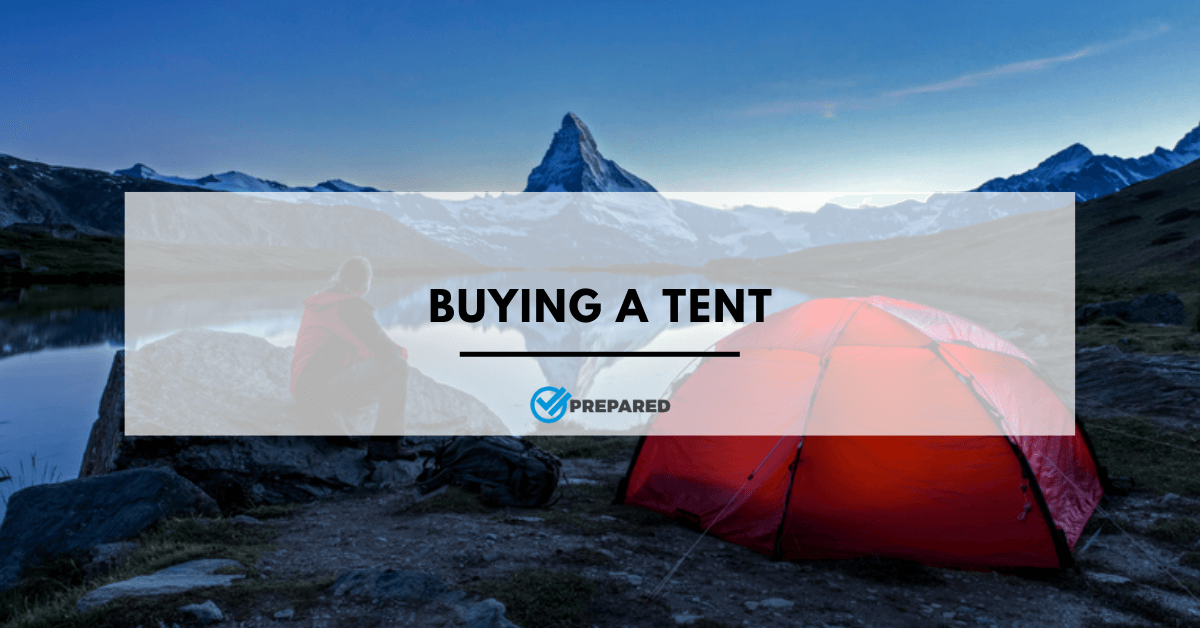It can be difficult to make a decision when buying a tent. There are many to choose from; some have two layers, some just one. Some are heavy, some light. Tents can be domes, tunnels or A-frames. Which one is best? Tents come in all shapes and sizes depending on your needs. This article provides an overview of the different types of tents and things to ask when buying a tent.
Main types of tents
Here is a list of some common types of tents available when buying a tent.
Dome (Freestanding or Non-freestanding): Dome tents are popular because they are lightweight, easy to set up and often stand on their own without stakes. Certain models have to be staked to the ground to stand up. Some have more poles making them stronger and able to withstand high winds and snow loading on top. Most dome tents have two layers, an inner with a waterproof bottom and mesh upper, and a waterproof outer. These “double-walled” tents have good ventilation. Because of less airflow, condensation can build up inside “single-walled” tents. These tents can be used in cold and warm, wet and dry climates. More mesh will be cooler. More poles will be strong but heavier.
A-frame and Ridge Tents: Ridge tents have been around for a long time. They get their name from their shape, a triangle at each end with a ridge along the top. Few or no poles means they are not strong in the wind but are quick to set up and relatively lightweight. High angle sides do not allow for much headroom.
Tunnel Tents: Tunnel tents can be single-walled or double-walled and have to be staked down to stand. They are easy to set up with few poles forming the hoops of the tunnel with entrances at one or both ends. They are usually spacious inside because of vertical walls with a good amount of covered area outside under the rainfly as a porch or vestibule. These types of tents can be used anywhere. They are waterproof but can have problems with the wind. High wind hitting the side of the tent instead of the end can push the tent over.
Tarps: Any size or type of tarp can be made into a decent shelter. Tarps can be used for creating lightweight shelters, and are popular among lightweight hikers and backpackers. Tarps can also be set up in many different configurations. They can be staked to the ground, tied to trees with rope or paracord, or propped up with hiking poles or branches. Tarp configuration can easily accommodate different environments like open fields or dense trees. There is no floors or bug protection to tarps. A thin plastic or waterproof sleeping bag cover can be used to stay dry off the ground while under a tarp. Some have separate liners available with netting and waterproof “bathtub” bottoms.
Floorless tents/Pyramids/Teepees: Floorless tents and pyramids are similar to tarps but cut in a specific way. Most can be pitched with a paddle or hiking pole and staked securely to the ground. They are well-ventilated but can be wet if the ground is wet. The main benefit is they are very lightweight.
Other Types of Tents: Other types of shelters are less common but may work in different situations:
- Quick pitch or pop-up: Pop-up tents have a spring-loaded pole that, when released, stands the whole tent up. They are not strong in high winds and can be hard to fix.
- Inflatable: A variation on the standard dome tent, the poles are inflatable tubes. These require a pump to set up and patch kits for punctures.
- Truck Tents: Truck tents are dome tents that attach to the bed of a truck. They are easy to set up and off the ground. They still need to be taken down to drive quickly, but at slow speeds, they will stay standing.
- Bivy sack: Bivy sacks are waterproof covers for sleeping bags. Some have mesh bug netting and short poles for more space inside. They are very lightweight but have no storage for gear out of the weather. They work well in combination with a tarp.
- Hammock: Lightweight hammocks with bug nets and a tarp make good shelters if there are trees around. If the wind is pushing rain in at an angle, gear under the tarp will get wet.
- Make your own: There are many different types of shelters you can build with materials available in nature. These can take valuable time and calories to build, but they do not require any weight to carry.
Eight things to think about when buying a tent
There is no perfect tent. They all have pros and cons depending on the situation. Reflect on these seven areas when buying a tent:
Type and Shape: Each of the different shapes and types from the list above offers different advantages. Is wind resistance a priority? What about weight? Is ease of set-up a priority?
How many seasons: 3, 3.5, 4: Tents usually come rated by the seasons they are good for:
- 3 season tents are good for spring, fall and summer. They are lightweight and waterproof but can’t withstand high winds and snow. They are open with mesh and will likely to be too cold in the winter.
- 3.5 season tents are stronger and heavier than 3 season tents. They have flaps to cover the mesh panels and trap heat inside. These can usually be used all year round.
- 4 season tents are strong and have less ventilation than other tents. They have more poles to hold up against the weight of snow and windstorms. Stronger fabrics and more poles mean they are heavier.
Single-wall or Double-wall: Most tents are double-walled, having a lightweight, breathable layer inside and a waterproof layer outside. This helps keep condensation to a minimum. Single-walled tents only have one layer of waterproof, breathable fabric with poles outside. They weigh less than double-walled tents but have more condensation inside. Too much condensation inside can cause gear and equipment to become wet.
Freestanding and Fast & Light Options: Freestanding tents can be pitched anywhere where there is appropriate space. Non-freestanding tents have to be staked to the ground to stand up. This can limit the locations a tent can be pitched. Some tents have fast and light options where just the fly and poles are used and not the inner mesh. This is lighter to carry but not as weather-resistant.
Ease of setup: Setting up a tent at night or in windy conditions is difficult. Pick a tent that is easy to set up. Having fewer poles and colour-coded clips make a tent easier to set up.
Size: Small tents can be tough to spend much time in. Pick a tent that has enough space for the time you want to spend there. Small tents are lighter in weight but provide less space for living during periods of inclement weather. Look for tents that have enough height inside to be comfortable, width inside to sleep the desired number of people and space in covered areas for gear.
Weight: Weight is an important issue if you are carrying your tent long distances. Lightweight tents weigh less than 5 pounds (2.2 kg). Tarps can weigh less than 2 pounds (1 kg). Lowering the weight of a tent usually decreases the comfort as well.
Colour: Tents come in a variety of colours. There may be situations where a brightly-coloured rainfly is not desired, and a more neutral color would work better.
Summary
There are many types of tents out there. Using this list will narrow down the different options to look at when buying a tent to stay safe and dry in the wilderness.

Chris was born and raised in South Africa and has worked in the field of risk management, organisational resilience, and business continuity for more than a decade. During his career he has seen how private and public sector organisations benefit from effective risk management and business continuity planning. Realising that families and communities can also benefit from the same tools, methodologies, and principles, he started Prepare with Foresight.
Prepare with Foresight was launched to assist individuals and families to have the peace of mind that they will be able to recover from and successfully adapt to the consequences of adverse events.

